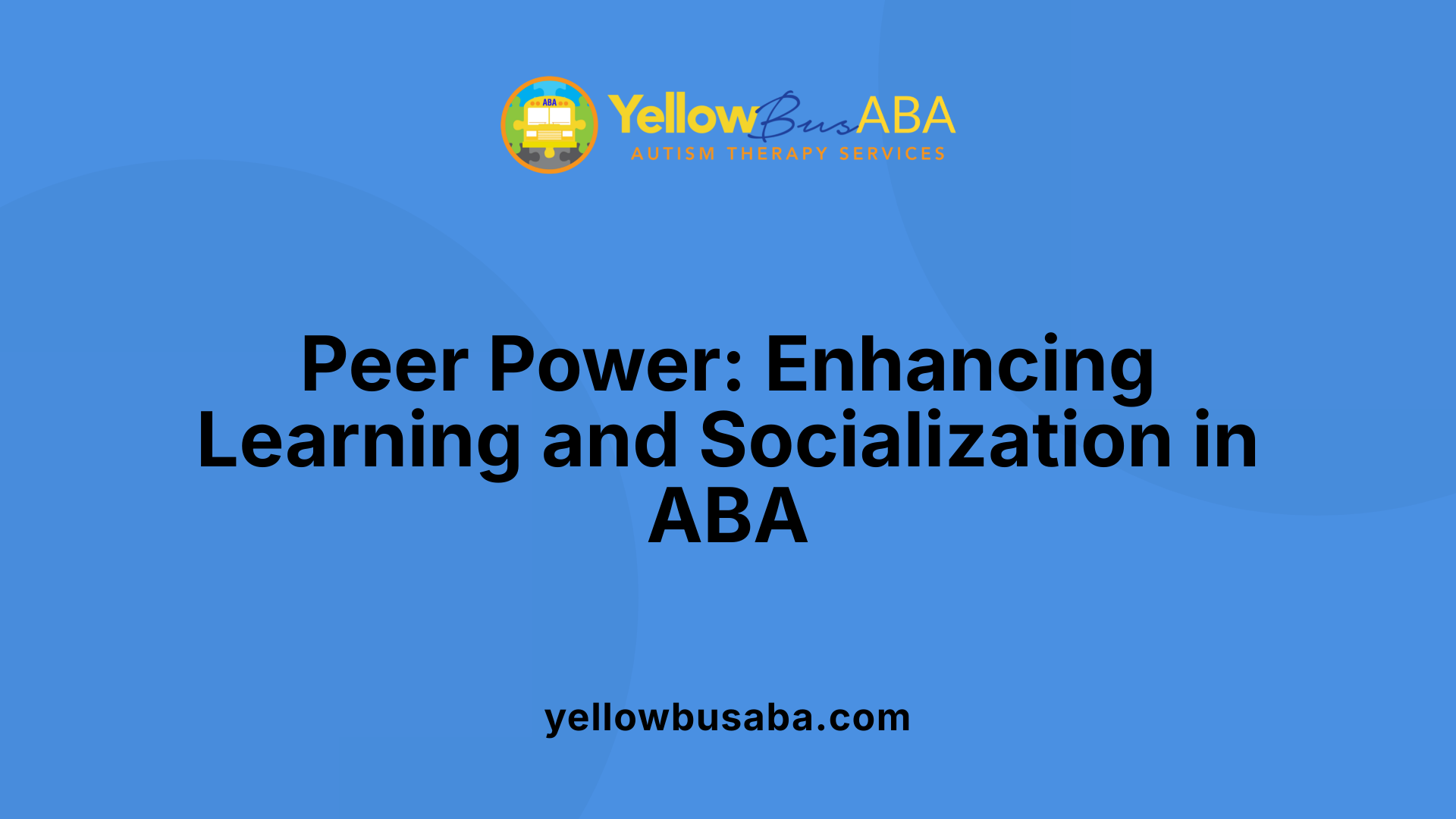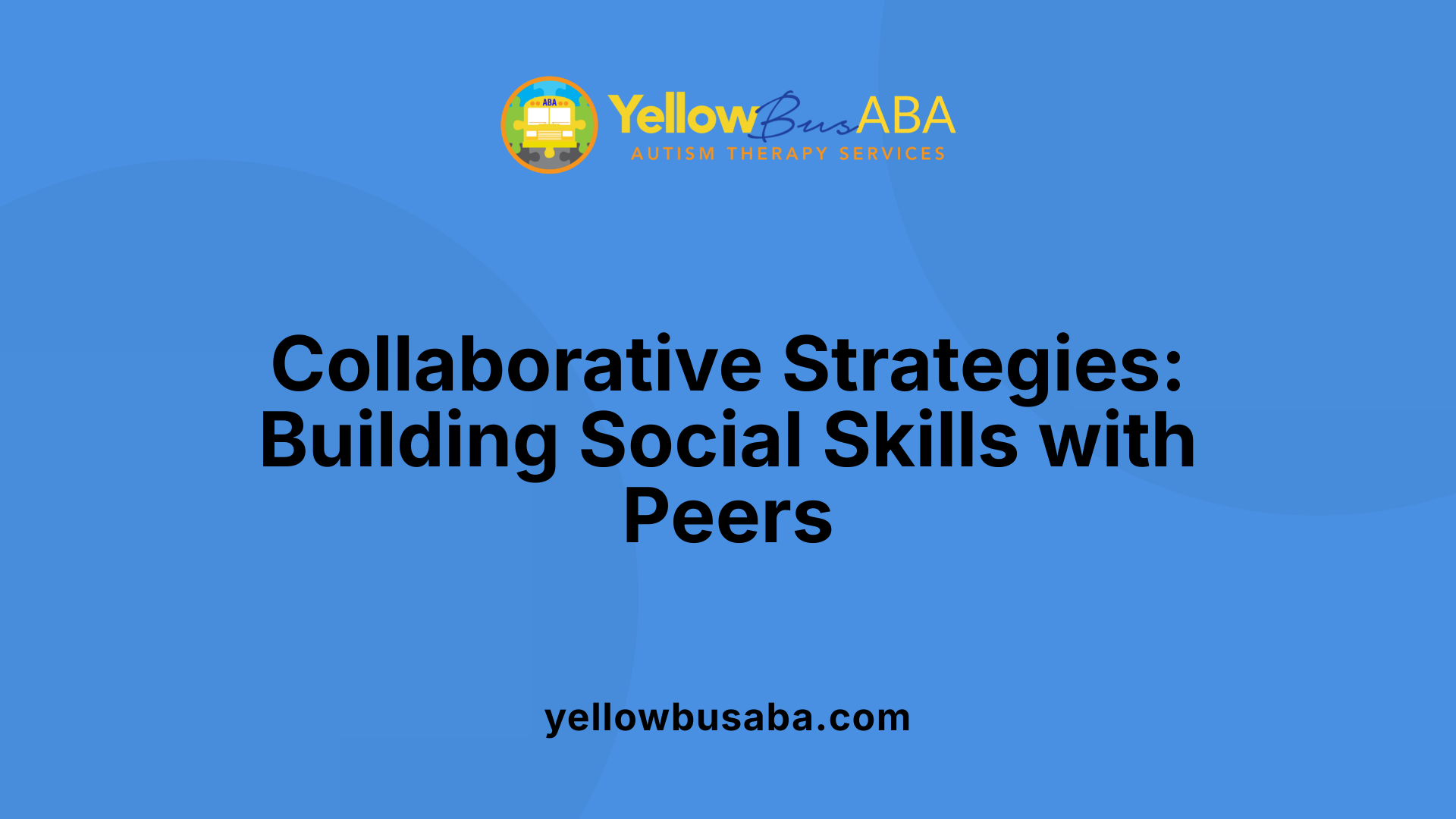Understanding Peer Interaction in ABA Therapy
Center-based ABA therapy is a cornerstone in supporting children with autism spectrum disorder (ASD), particularly because it provides a structured and consistent environment optimized for developmental progress. Among the various techniques employed, peer interaction plays a pivotal role in fostering social skills and improving therapeutic outcomes. This article explores how social engagement, especially peer-mediated activities, influence developmental trajectories, support social skills development, and contribute to the overall effectiveness of ABA therapy in a center-based setting.
The Significance of Early Diagnosis and Social Engagement Strategies

Why are early diagnosis and social engagement strategies important in early intervention for autism?
Early diagnosis of autism is crucial for initiating effective treatment as soon as possible. When autism is identified early, interventions such as ABA therapy can begin at a young age, maximizing their impact on development. Early intervention is associated with better language skills, social understanding, and reduced severity of autism symptoms.
Tools like eye-tracking are increasingly used for early detection. Eye-tracking measures can objectively observe how children look at faces, objects, or social scenes, providing valuable early biomarkers. Such technology allows for identification of autism in children younger than 3 years old, often before behavioral symptoms become fully apparent.
Early diagnosis is only part of the equation. Incorporating social engagement strategies into interventions addresses core deficits in social communication and interaction. These strategies promote social motivation and teach children how to initiate and sustain social interactions. For example, ABA therapy employs techniques like peer interaction, role-playing, and social skills training to help children learn essential skills such as sharing, turn-taking, and emotional regulation.
Furthermore, caregiver involvement enhances social development. Training parents and family members to reinforce social skills at home creates consistency across environments and accelerates progress. Reducing environmental risks, such as limiting screen time, helps children engage more naturally with their surroundings.
By combining early diagnosis with targeted social engagement efforts, intervention programs leverage the brain's plasticity during critical developmental windows. This approach significantly improves the likelihood of positive outcomes, including better communication, social competence, and reduced autism severity, providing children with a stronger foundation for future growth.
Benefits of Incorporating Peer Interactions in ABA Sessions

What are the benefits of incorporating peer interactions into center-based ABA therapy sessions?
Integrating peer interactions into ABA therapy sessions at centers provides many positive outcomes for children with autism. One of the main advantages is enhancing social motivation and engagement. When children participate in activities with peers, they become more interested and involved in social exchanges, which motivates them to practice skills.
Peer involvement helps children generalize their social and communication abilities to real-world environments such as school or community settings. During group activities like games, role-playing, or collaborative projects, children practice essential social behaviors such as sharing, turn-taking, and problem-solving in a supportive context.
This structured interaction also offers natural opportunities for children to imitate social cues, understand social norms, and develop emotional understanding. Over time, these experiences can boost children's confidence and help them form friendships.
Overall, including peers in ABA therapy turns individual learning into an engaging, social experience. It creates a dynamic environment that promotes meaningful social development and supports the child’s overall growth in social skills.
Impact of Social Engagement and Peer Interaction on Developmental Progress

How does social engagement and peer interaction influence developmental progress in children with autism during therapy?
In center-based ABA therapy, social engagement and peer interactions are vital components that significantly boost development. These activities directly target the improvement of social, communication, and adaptive skills essential for children with autism.
Therapists incorporate motivational and personalized activities, often relating to the child’s interests, to foster engagement. This approach encourages children to participate actively, promoting behaviors such as eye contact, verbal initiation, and positive emotional responses. Embedding social activities into natural routines helps children generalize these skills beyond the therapy setting.
Technology also plays a role in enhancing social engagement. Automated measurement tools and social robots are utilized to monitor progress and sustain interest. These tools can provide consistent, engaging stimuli that adapt to each child's responses, making therapy more effective.
Peer and adult mentorship further elevates social interaction levels. Structured group activities, like cooperative play and social imitation, reinforce social norms, emotional regulation, and communication skills. Such interactions prepare children to navigate real-world social contexts more confidently.
Family involvement also supports these efforts. Parents trained to facilitate social interactions at home and in community settings help reinforce skills learned during therapy. The combination of motivation, personalized activities, relevant technology, and social relationships creates a comprehensive framework that accelerates developmental progress.
Ultimately, fostering social motivation and providing supportive relationships during therapy encourages children with autism to develop essential social, communication, and adaptive skills, paving their way to improved functioning across various environments.
Supporting Social Skills Development with Peer Interaction

In what ways does peer interaction support social skills development in children with ASD during ABA therapy?
Peer interaction is a fundamental aspect of ABA therapy that greatly enhances social skills in children with autism spectrum disorder (ASD). Through structured group activities and peer play, children have the chance to practice real-life social behaviors in a safe environment.
One of the primary benefits is providing opportunities for children to observe and imitate appropriate social cues. For instance, they learn turn-taking, sharing, greeting others, and initiating conversations. These behaviors are reinforced through interactions with peers, which makes the learning experience more natural and meaningful.
Video modeling, role-playing, and social skills training are incorporated within peer interactions to further develop communication abilities. Children practice verbal and non-verbal cues, such as eye contact, tone of voice, and facial expressions, which are vital for successful social exchanges.
Using positive reinforcement, therapists encourage children to engage actively and confidently in social settings. As children become more comfortable, they generalize these skills from therapy sessions to everyday environments like school and community settings.
This process not only improves social responsiveness but also boosts confidence and the ability to form friendships. Building social competence through peer interaction fosters empathy, emotional understanding, and meaningful social connections.
How does peer interaction help with the generalization of social cues?
Generalization is a core goal of ABA therapy, aiming for children to apply learned skills across various settings. Peer interaction significantly contributes to this by providing consistent, real-world practice.
Children learn to interpret social cues such as gestures, body language, and facial expressions during peer activities. Repeated exposure in the structured environment of therapy helps these behaviors become habitual.
Moreover, collaborative group activities like games, cooperative play, and group discussions enable children to transfer skills learned during individual sessions to diverse social contexts. This increases the likelihood that they will apply these skills outside therapy, across school, community, and family environments.
How does this method enhance confidence and social competence?
Engaging regularly with peers in a supportive setting allows children with ASD to build trust and emotional resilience. Successful social interactions, reinforced positively, foster a sense of achievement and self-esteem.
As children practice interacting with peers, they become more adept at understanding social norms—such as respecting personal space, taking turns, and sharing. This competence leads to more positive social experiences, creating a cycle of confidence and further skill development.
Which techniques are used to promote social skills through peer interaction?
ABA therapists employ various evidence-based strategies during peer interactions, including role-playing and reinforcement techniques. Role-playing allows children to simulate social situations and practice appropriate responses.
Reinforcement, such as praise or tangible rewards, motivates children to participate actively. Natural environment training, which integrates social skills practice into everyday routines, supports meaningful learning.
Overall, fostering peer interactions in a structured, supportive environment helps children with ASD develop essential social skills, gain confidence, and learn to navigate social settings more effectively.
Collaborative and Social Aspects of ABA Involving Peer Interactions

What are the collaborative and social aspects of ABA therapy that involve peer interactions?
ABA therapy places a strong emphasis on fostering social skills through collaborative and peer-involved activities. One primary approach includes structured group activities that encourage children to interact, practice social behaviors, and learn from peers. These activities often involve peer-mediated interventions, where typically developing children are trained to model and reinforce positive behaviors, helping children with autism engage in shared play and communication.
In addition to structured activities, ABA emphasizes naturalistic settings. Therapy sessions occurring in classrooms, community centers, or other real-world environments support the application of social skills in everyday situations. This environment allows children to practice greetings, sharing, turn-taking, and understanding social cues within a context they are likely to encounter outside therapy.
Collaboration among professionals such as behavior analysts, teachers, speech therapists, occupational therapists, and parents enhances the effectiveness of peer-related strategies. A multidisciplinary team develops tailored plans that promote consistent reinforcement across settings, helping children build lasting friendships and social competence.
Building inclusive peer relationships is a vital goal. Through targeted interventions like role-playing, modeling, and positive reinforcement, children learn to navigate social interactions better. This collaborative effort aims to reduce social anxiety, improve social communication, and foster inclusive social experiences, ultimately empowering children with autism to participate meaningfully within their peer groups.
Enhancing Therapy Effectiveness through Peer Interaction
What is the impact of peer interaction on the effectiveness of center-based ABA therapy?
Peer interaction is a vital component that significantly boosts the success of center-based ABA therapy for children with autism. When children engage with peers through structured activities, they gain valuable opportunities to practice essential social skills such as communication, sharing, and turn-taking. These peer-mediated interventions help children learn to interpret non-verbal cues and develop emotional recognition abilities in realistic social contexts.
Group activities, including cooperative games and social imitation exercises, serve as natural settings for skill generalization—the process of applying learned behaviors across environments. Such experiences foster increased motivation and engagement, making therapy more effective and enjoyable.
Research highlights that integrating peer interaction early in intervention can help reduce behavioral issues and ease social anxiety. The presence of supportive peer relationships not only enhances emotional understanding but also encourages children to participate actively in social exchanges.
Innovative approaches like virtual reality and peer pairing platforms can further reinforce social skills and emotional recognition. These tools create immersive, motivating scenarios where children with autism can safely practice social interactions and build confidence.
Ultimately, peer interaction in a structured, supportive environment amplifies the benefits of ABA therapy. It helps children develop critical social competencies, facilitating smoother integration into school, community, and everyday life.
Structuring and Utilizing Peer Interactions in Therapy Environments
How are peer interactions structured and utilized within ABA therapy environments?
In ABA therapy centers, peer interactions are carefully organized to boost social engagement and skill development. Therapists design group activities that encourage children to practice social behaviors such as sharing, turn-taking, and responding to social cues.
These activities often combine direct instruction with prompts and positive reinforcement to motivate children and shape their behaviors. For example, children might participate in cooperative games or joint activities where therapists use visual supports and verbal cues to guide interactions.
A significant aspect of this approach is utilizing peer models — children who demonstrate appropriate social behaviors. Observing and mimicking peers allow children with autism to learn social norms naturally and comfortably.
Group settings provide a rich environment for practicing skills like emotional regulation and communication in a safe, predictable context. Children learn to interpret social cues, respond appropriately, and develop friendships.
Furthermore, structured peer interactions enhance motivation by making learning engaging and meaningful. They help children transfer skills from the therapy setting to other environments like school and community.
Overall, ABA therapy environments integrate well-planned peer interactions that serve as powerful tools for nurturing social skills and confidence in children with ASD, making social learning a natural part of their development.
Harnessing Social Learning for Better Outcomes
Children with ASD benefit significantly from the integration of peer interactions within center-based ABA therapy, which is essential for fostering social competence, emotional understanding, and overall developmental progress. Structured activities, naturalistic play, and peer-mediated strategies create dynamic learning opportunities that promote the generalization of social skills to real-life settings. Early diagnosis combined with targeted social engagement strategies, including fostered peer relationships, ultimately leads to improved confidence and more inclusive social participation. The collaborative efforts of multidisciplinary teams, along with family involvement, reinforce the gains achieved in therapy, making peer interaction a cornerstone of effective autism intervention and support.
References
- The Role of ABA Therapy in Early Intervention for Autism
- Center-Based ABA Therapy Advantages for Autism Care
- Benefits of Center-Based Therapy for Autistic Children - Move Up ABA
- The Impact of Center Based ABA Therapy on Children with Autism
- Group ABA Therapy: How Peer Interaction Enhances Learning for Kids
- Group Instruction in ABA: A Practical Guide - Alpaca Health
- (PDF) Peer Training to Facilitate Social Interaction for Elementary ...
- Social Skills Development Through Peer Interaction for Kids with ...
- Peer Play in Cleveland ABA Therapy
- How ABA Therapy Enhances Social Skills in Children with ASD



.jpg)

.avif)
